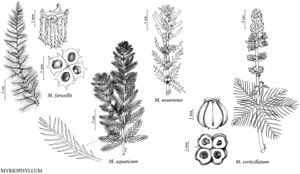Myriophyllum farwellii
Bull. Torrey Bot. Club 18: 146. 1891.
Herbs monoecious, aquatic, often forming dense stands. Rhizomes absent. Stems delicate, often branched, to 1 m, with numerous black, ascidiate trichomes. Turions present, green to brown, very narrowly cylindrical, with gradual and moderate transition from foliage leaves to slightly reduced turion leaves, to 10 cm, apex ± rounded; leaves pectinate and stiff, strongly appressed to axis, elliptic to narrowly obovate in outline, 11–23(–40) × 1.5–3(–4) mm; segments 6–12(–14), longest segment (1.5–)3–5.5 mm, basal segment less than or equal to 2/3 central axis of leaf, apex acute; brown, ascidiate trichomes scattered on surfaces and in axils. Leaves all submersed, usually in whorls of 3(or 4), sometimes alternate or subverticillate, homomorphic; petiole 0–3 mm; leaves pectinate, ovate to elliptic or obovate in outline, (6–)10–20(–25) × (4–)7–15 mm, segments (7–)10–14(–16), linear-filiform, longest segment (4–)8–15(–22) mm, with black ascidiate trichomes scattered on surfaces and in axils. Inflorescences submersed, to 30 cm; flowers bisexual; bracteoles cream, trullate, 0.2–0.5(–0.8) × (0.1–)0.3–0.5 mm, margins entire or irregularly lobed, lobes with glandular fringe. Bisexual flowers: sepals green to cream or ± purple, ovate to trullate, 0.1–0.5(–0.7) × 0.1–0.3(–0.5) mm; petals persistent, cream to purple, elliptic to obovate, 0.6–1.3 × 0.3–0.8 mm; stamens 4, filaments to 0.5 mm, anthers 0.2–0.4 × 0.1–0.3 mm; pistils 0.8–1.2 × 0.2–0.3 mm, stigmas red to ± purple, to 0.5 mm. Fruits cylindric to subglobose, deeply 4-lobed. Mericarps tan to brown, cylindric, (1–)1.5–2.5 × 0.5–0.9 mm, transversely hexagonal (rounded to obtusely angled adaxially), abaxial surface shallowly 4-angled, smooth or sparsely tuberculate, with 4 longitudinal ridges, ridges with irregular, shallow to pronounced, membranous wings, ribs absent. 2n = 14.
Phenology: Flowering and fruiting Jun–Aug.
Habitat: Oligotrophic to mesotrophic, often highly tannic waters, lakes, ponds, and marshes.
Elevation: 0–600.
Distribution
B.C., Man., N.B., Nfld. and Labr. (Nfld.), N.S., Ont., Que., Alaska, Conn., Maine, Mass., Mich., Minn., N.H., N.Y., Pa., R.I., Vt., Wis.
Discussion
Myriophyllum farwellii is distinguished from other water-milfoils, except M. humile, by submersed flowers and fruits in the axils of foliage leaves. It differs from M. humile by having distinctly larger, winged mericarps that are transversely hexagonal, versus smaller, wingless mericarps that are transversely elliptic to ovate. It produces elongate turions by midsummer with stiff, reduced leaves. These reduced leaves, which are dark green to black, are often visible at the base of new shoots in the next growing season, which can be an aid for identification. Its foliage leaves are mostly produced in whorls, contrary to what has been stated in the literature concerning an alternate or opposite arrangement.
Selected References
None.
